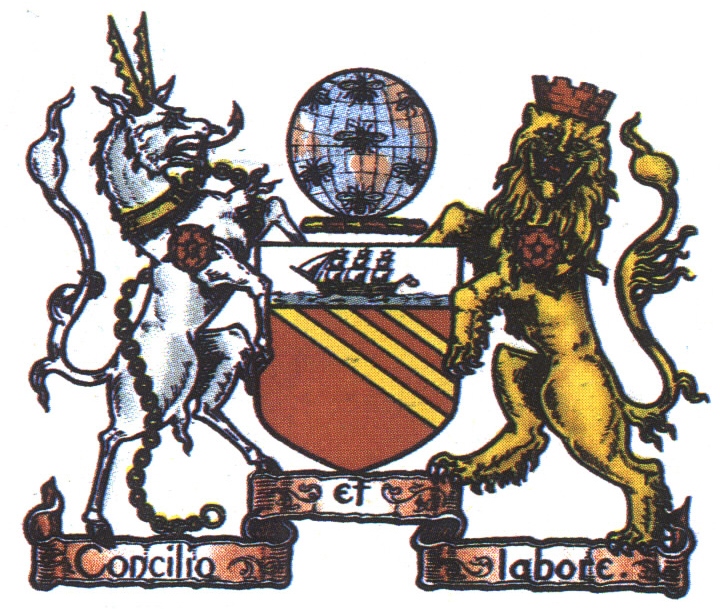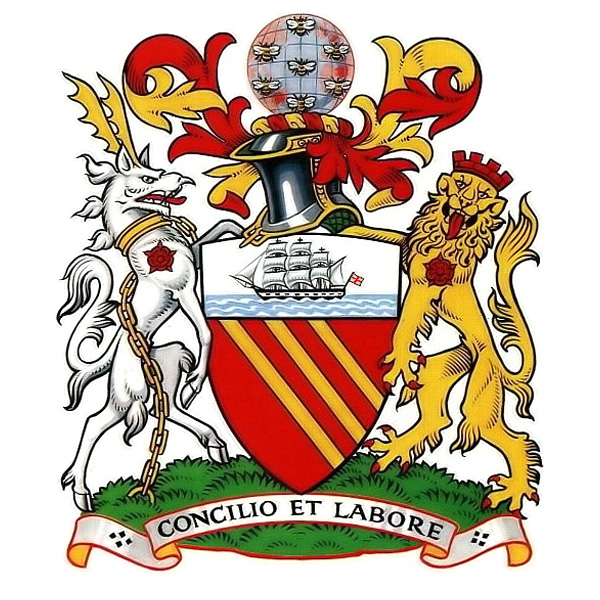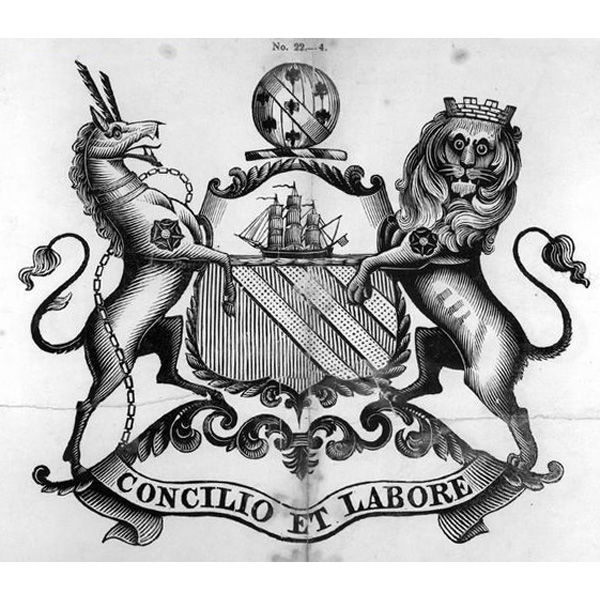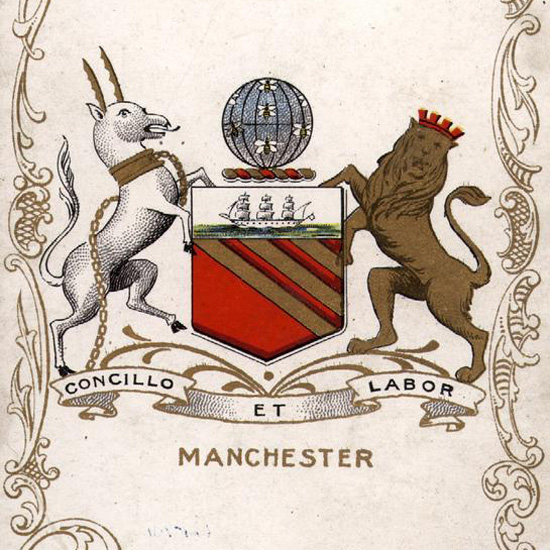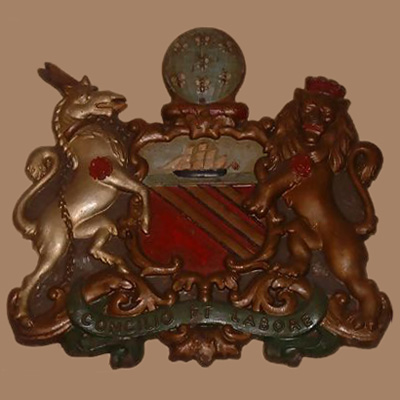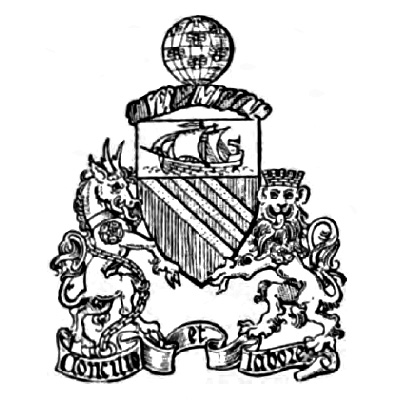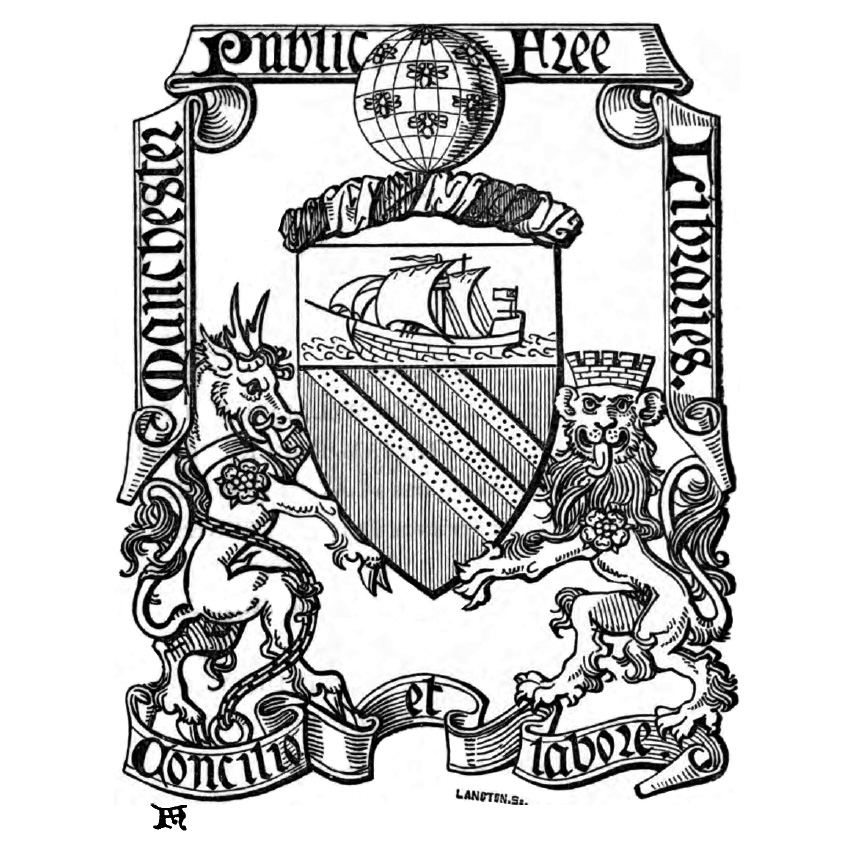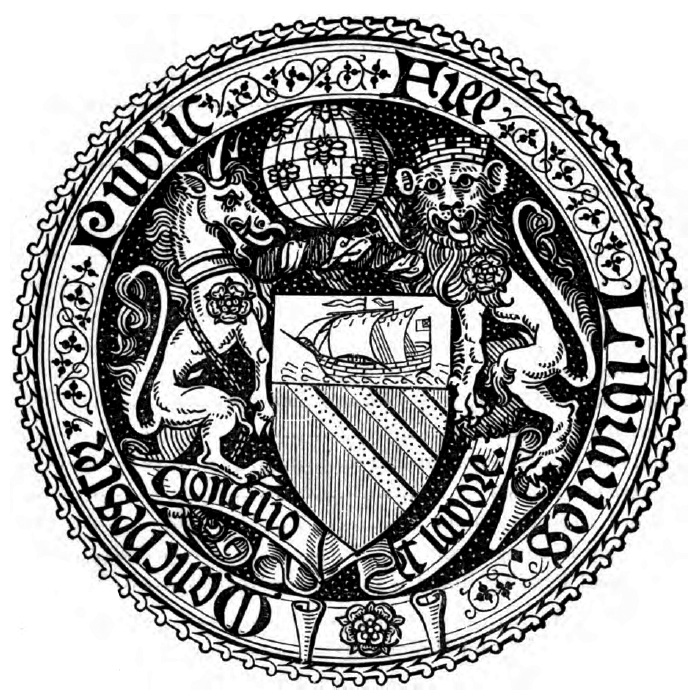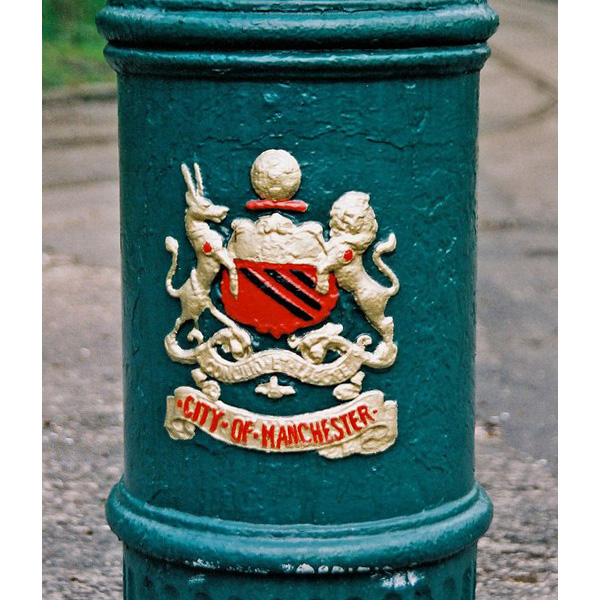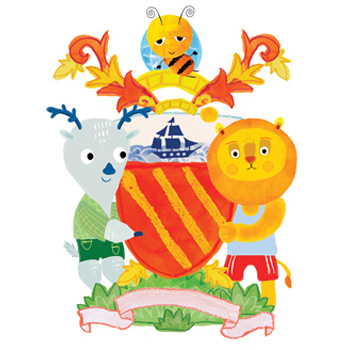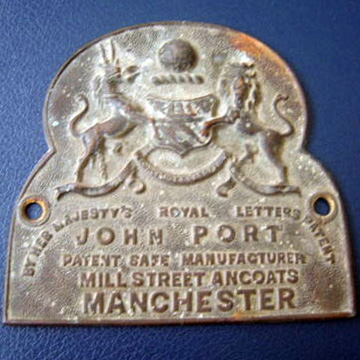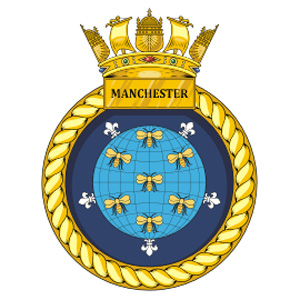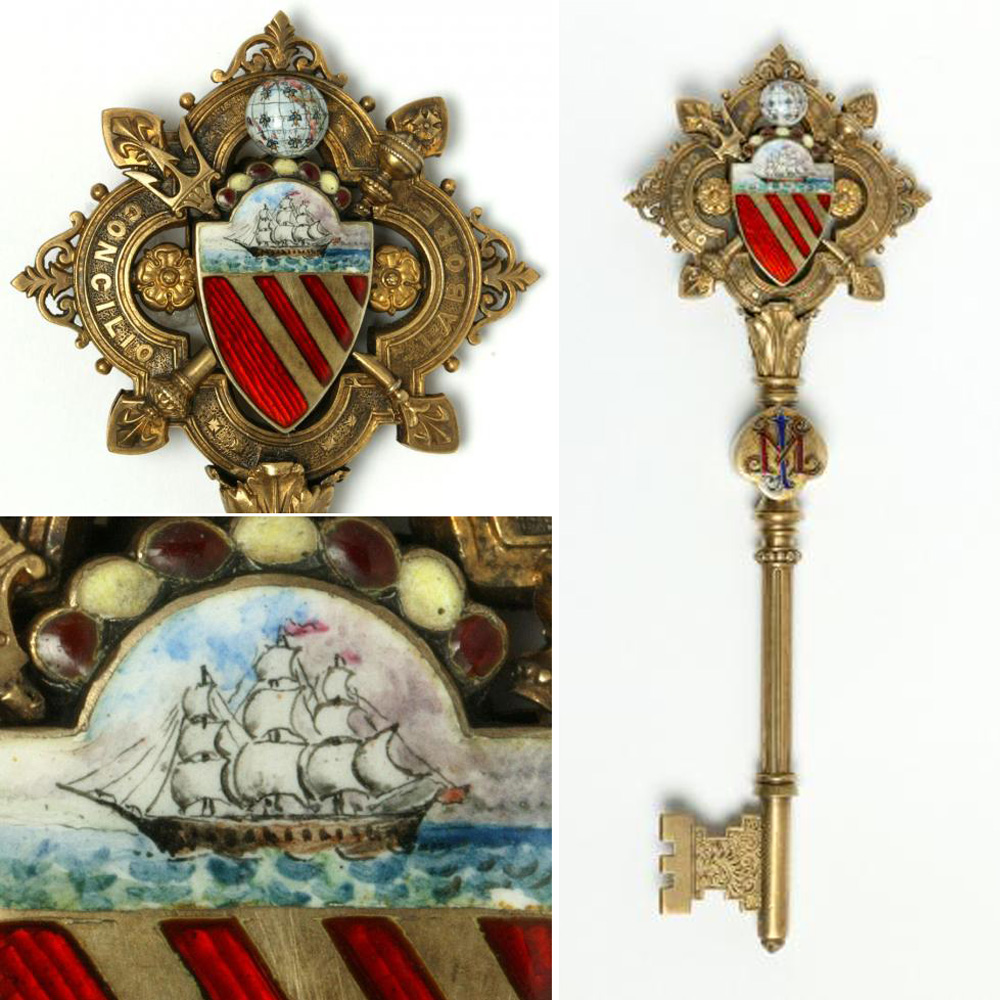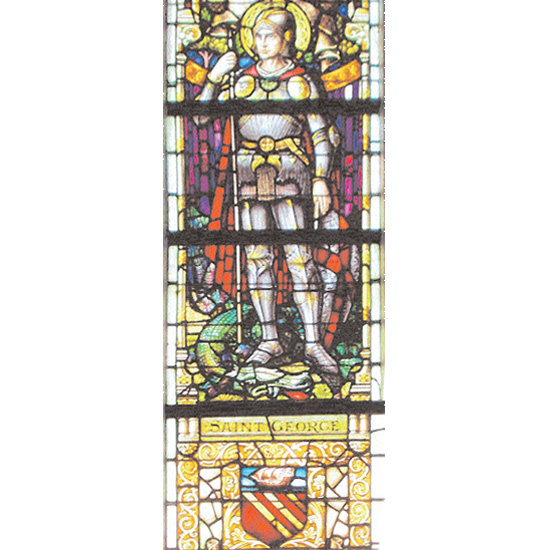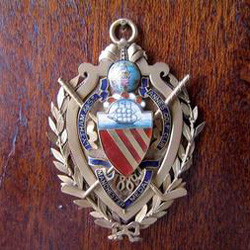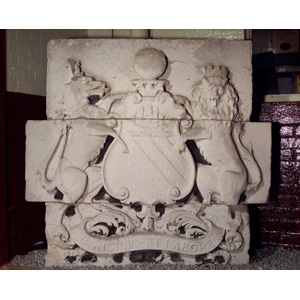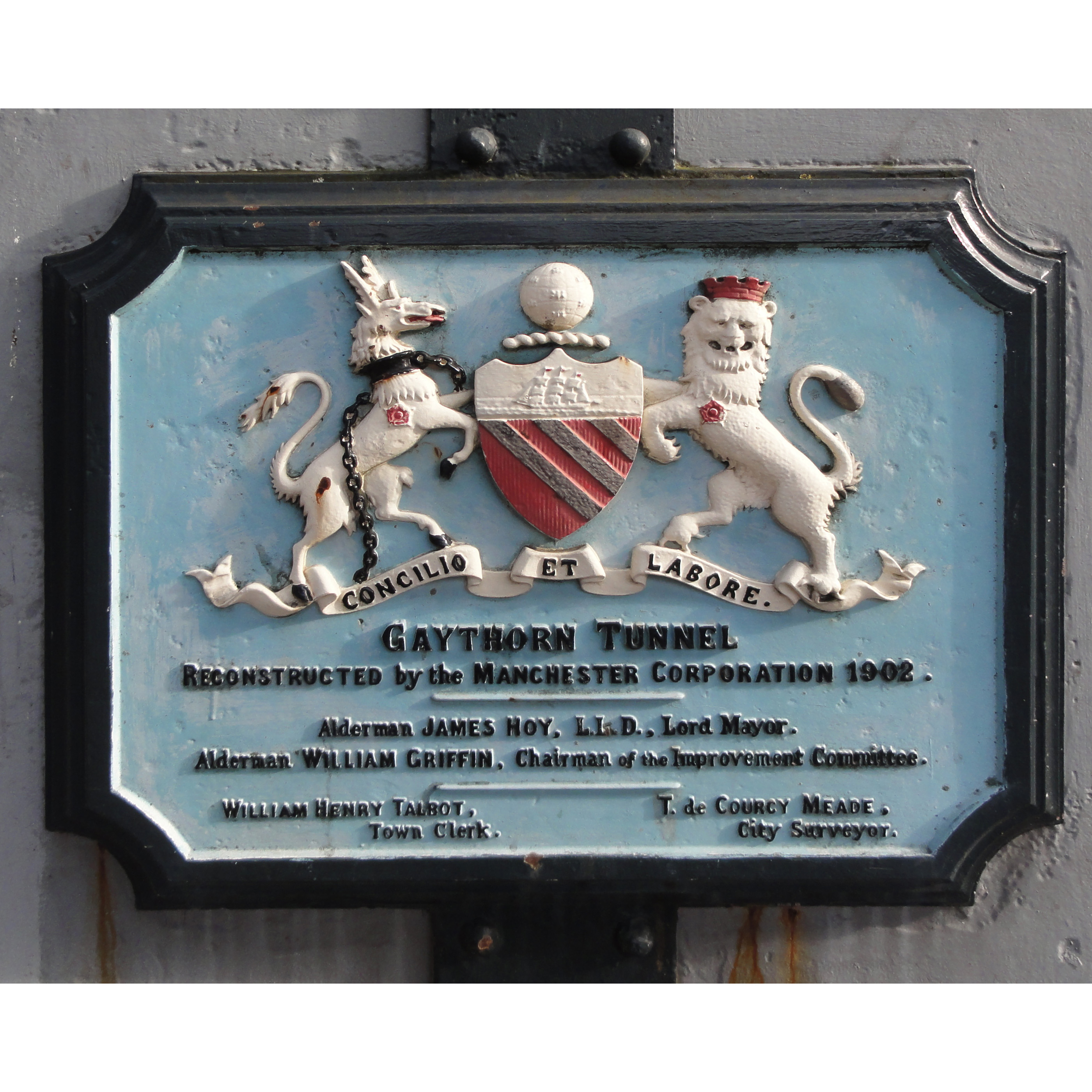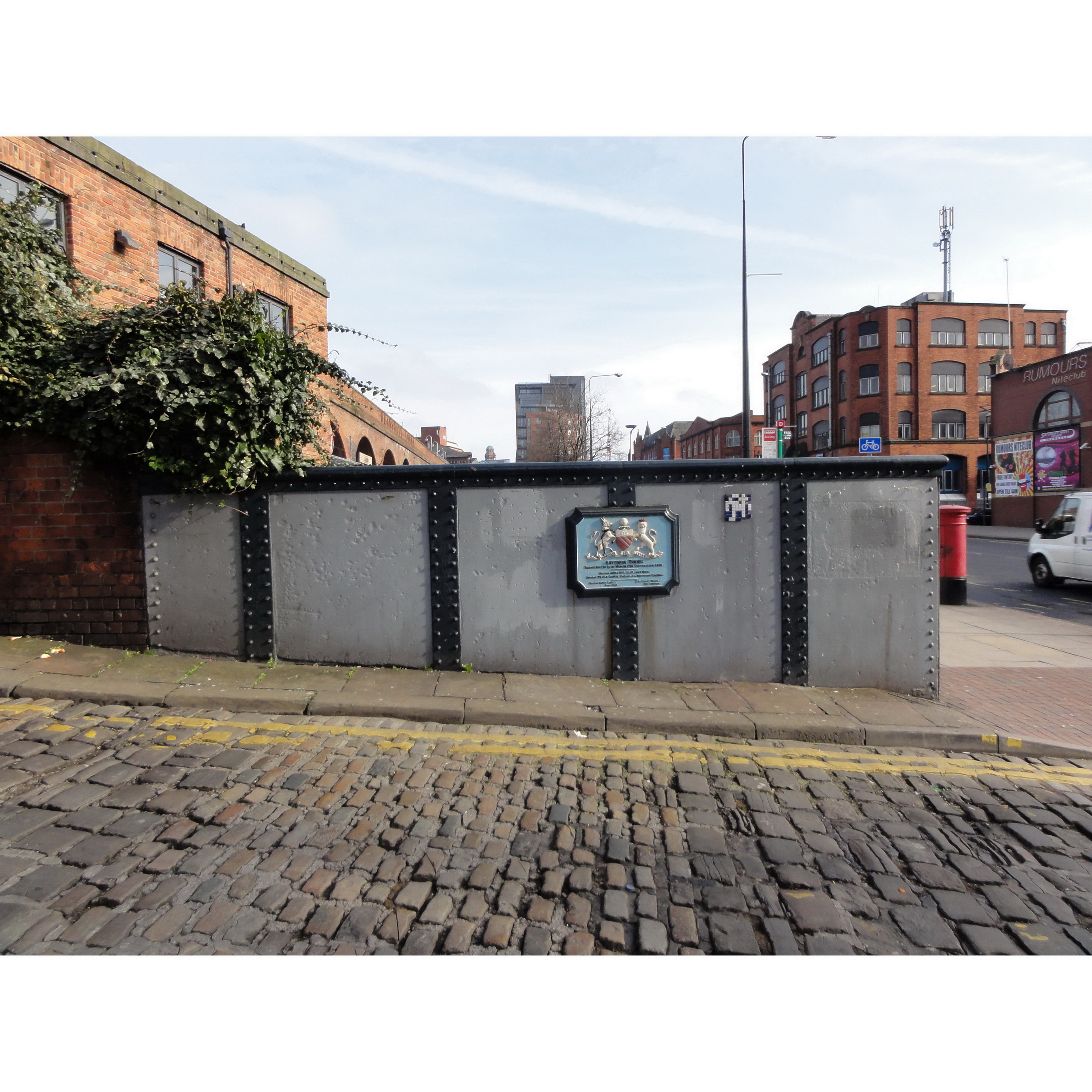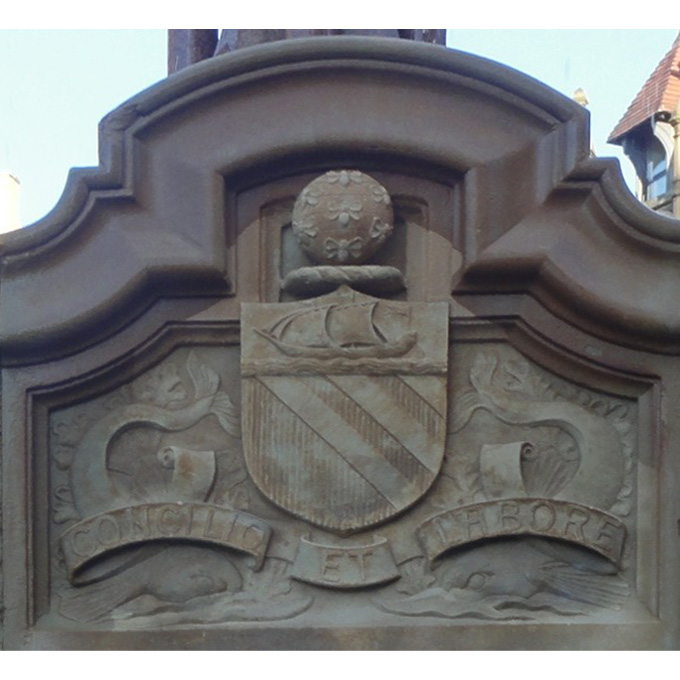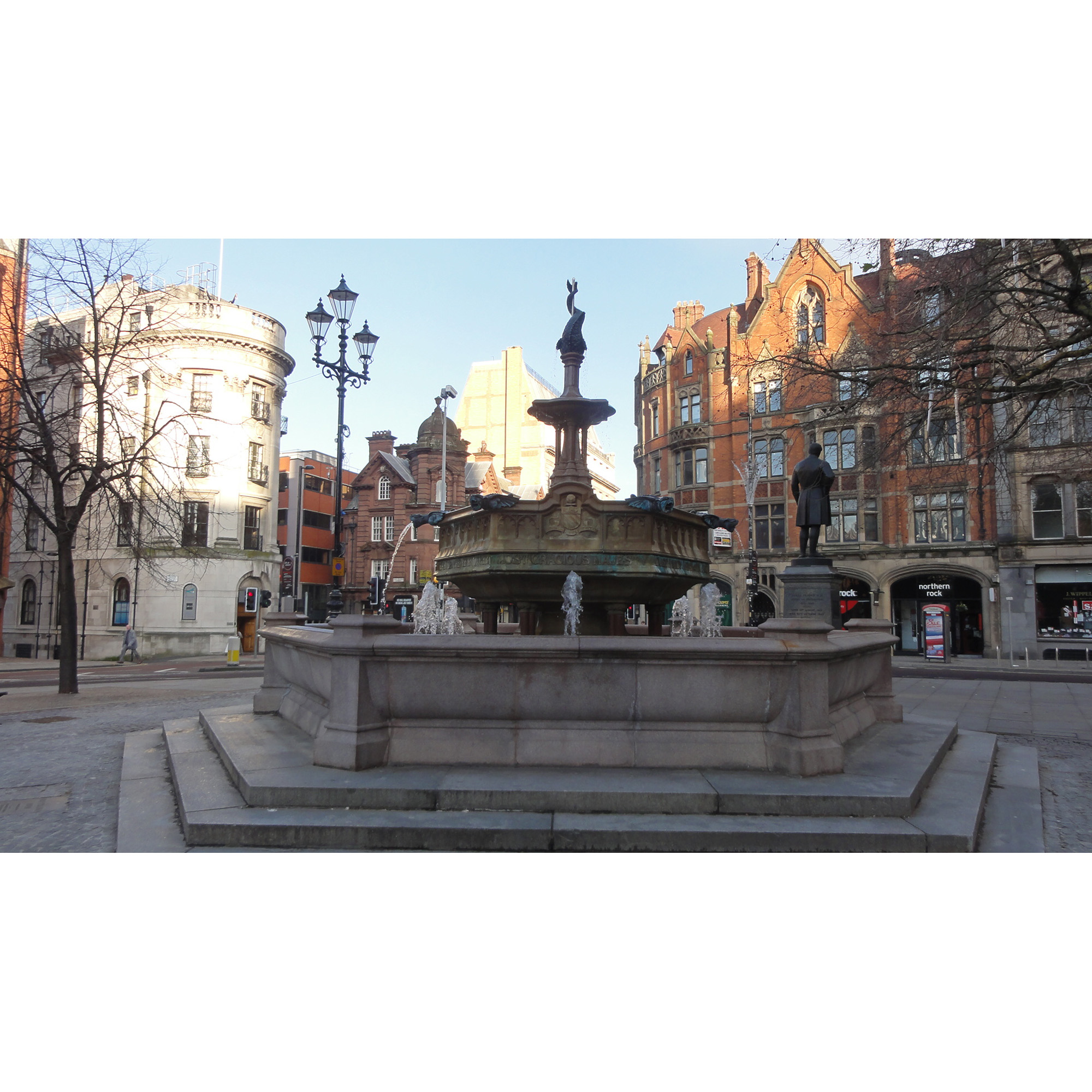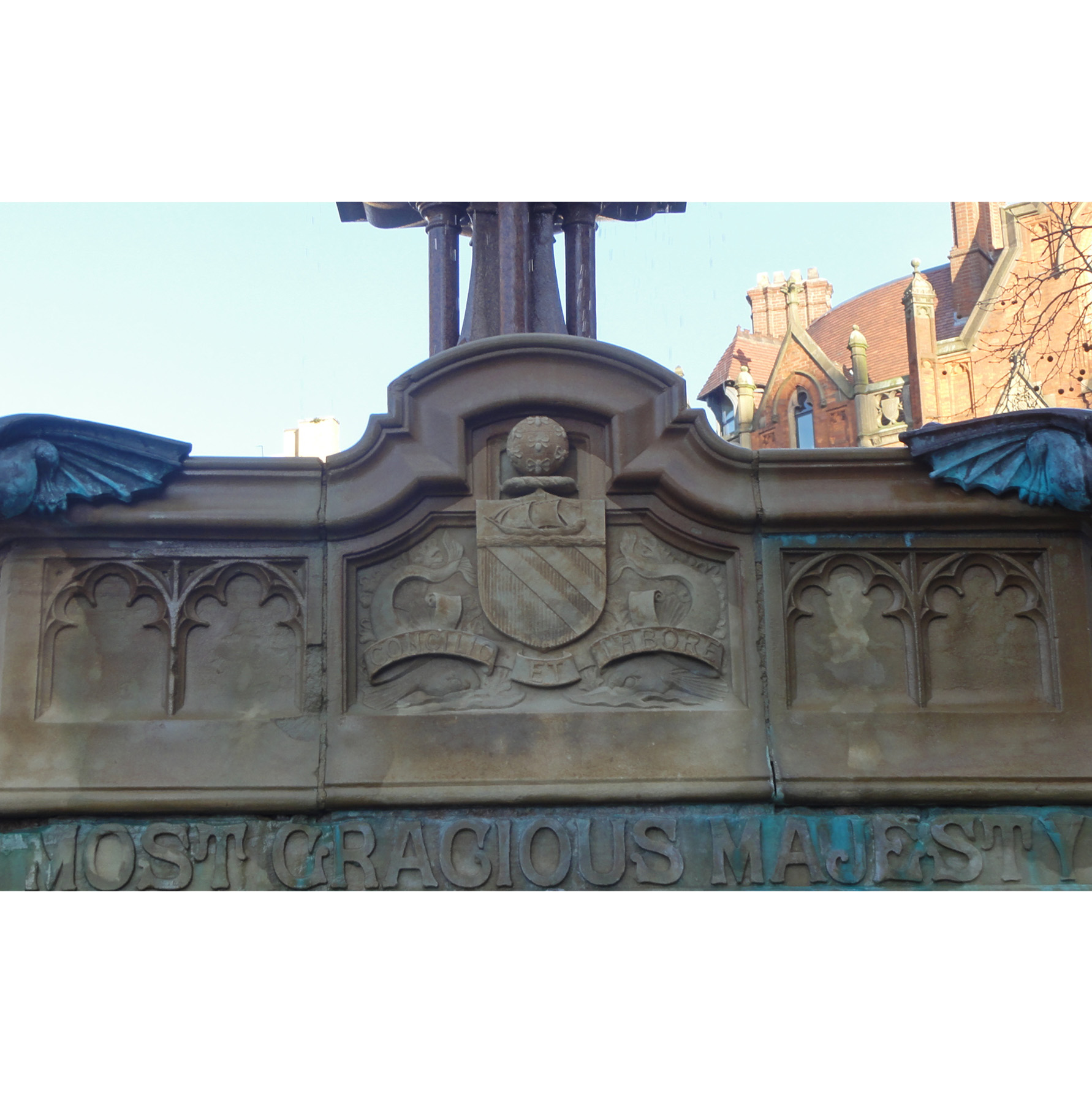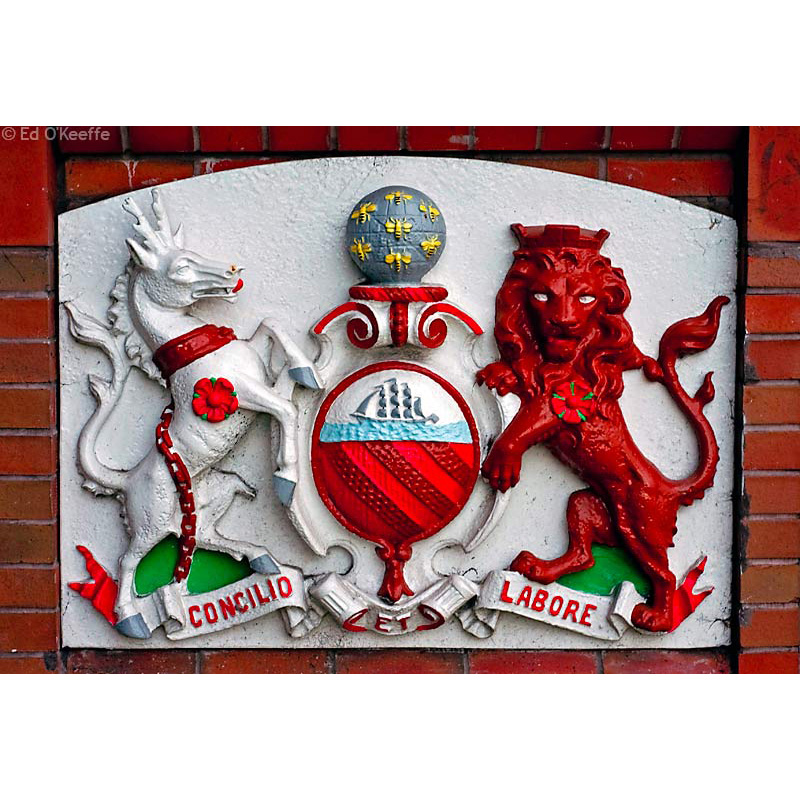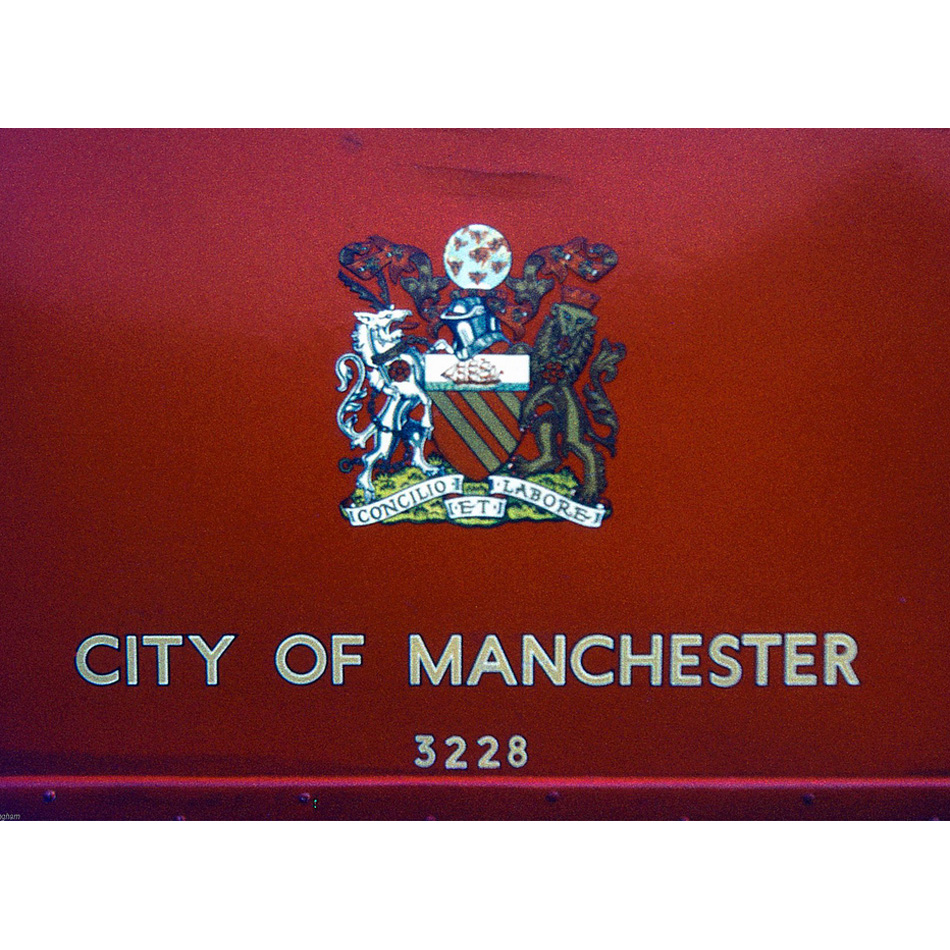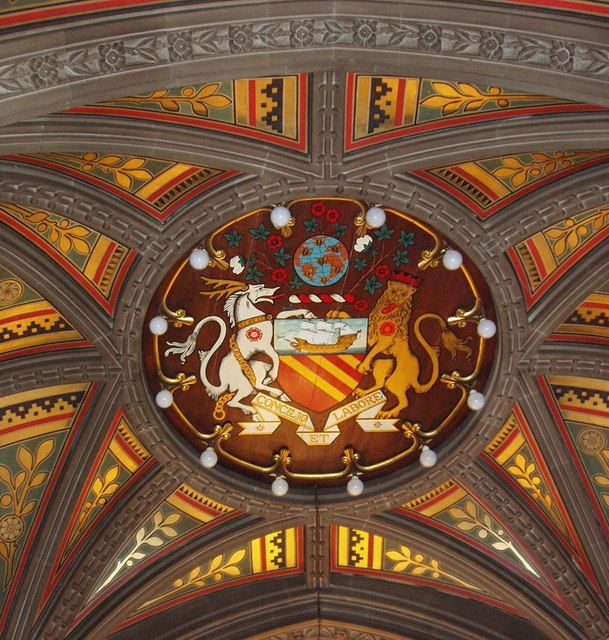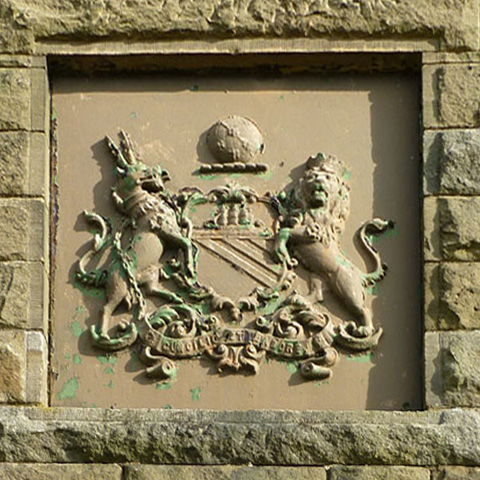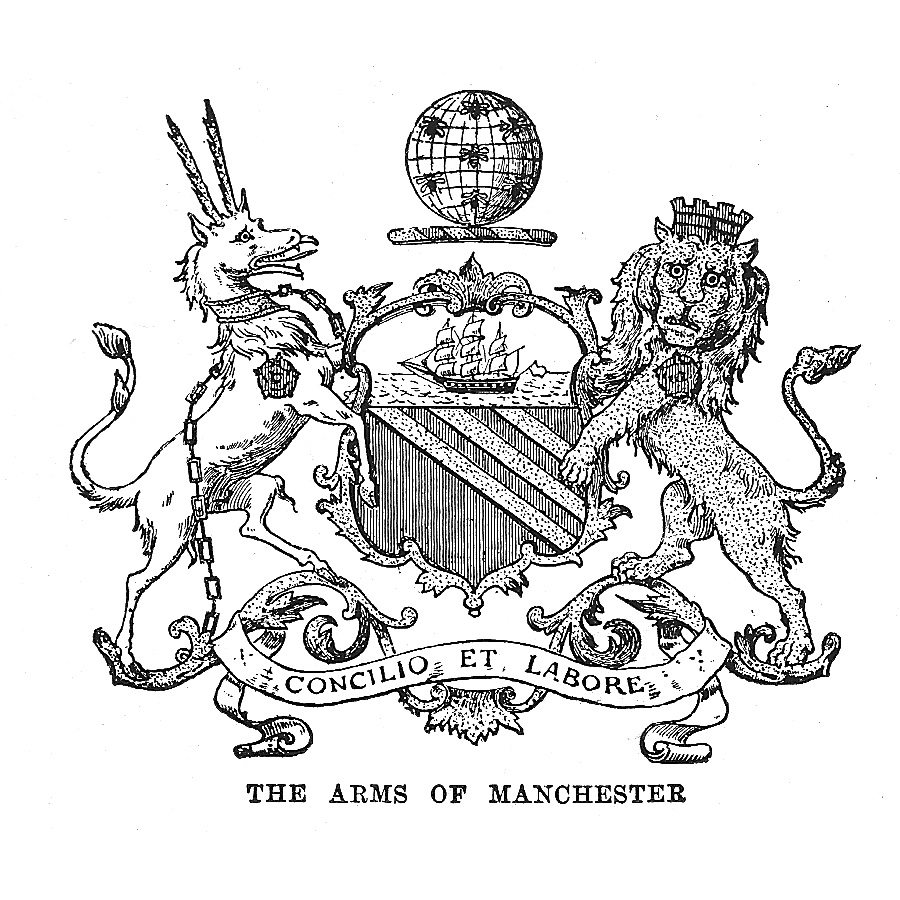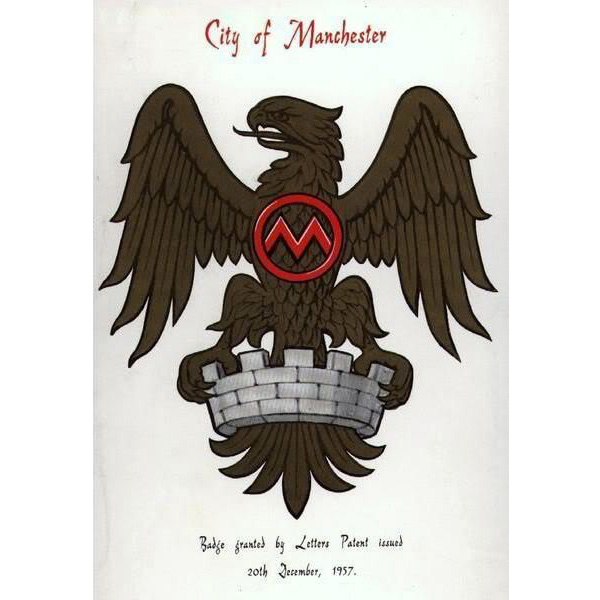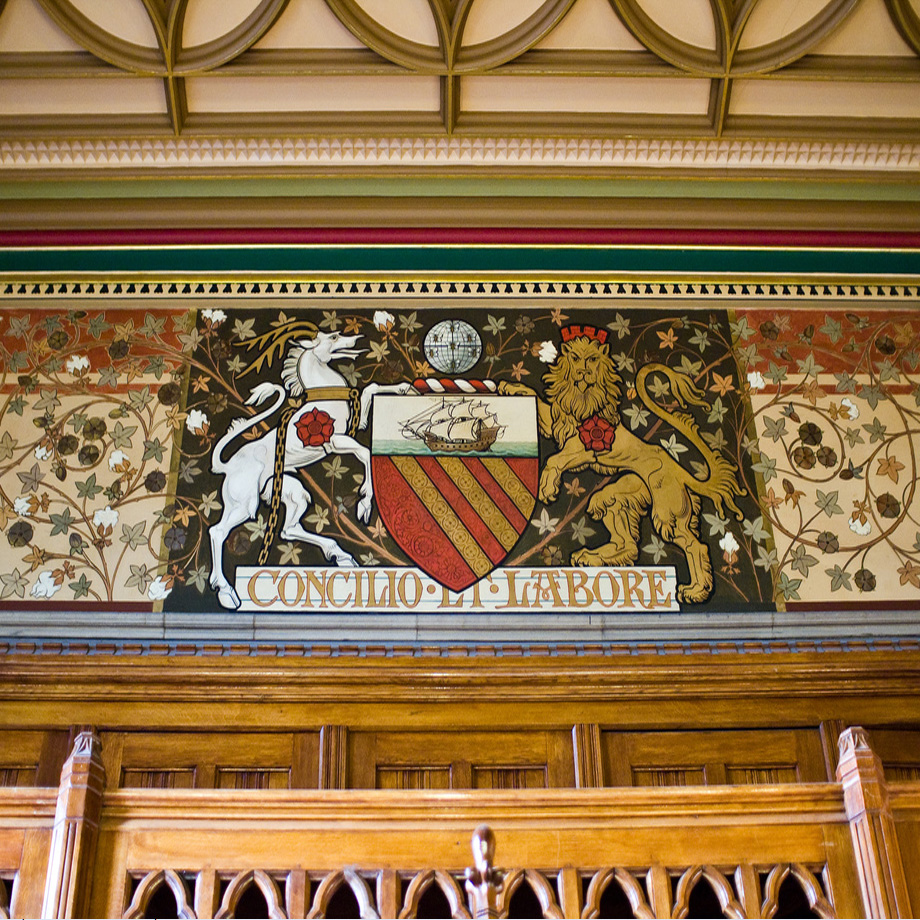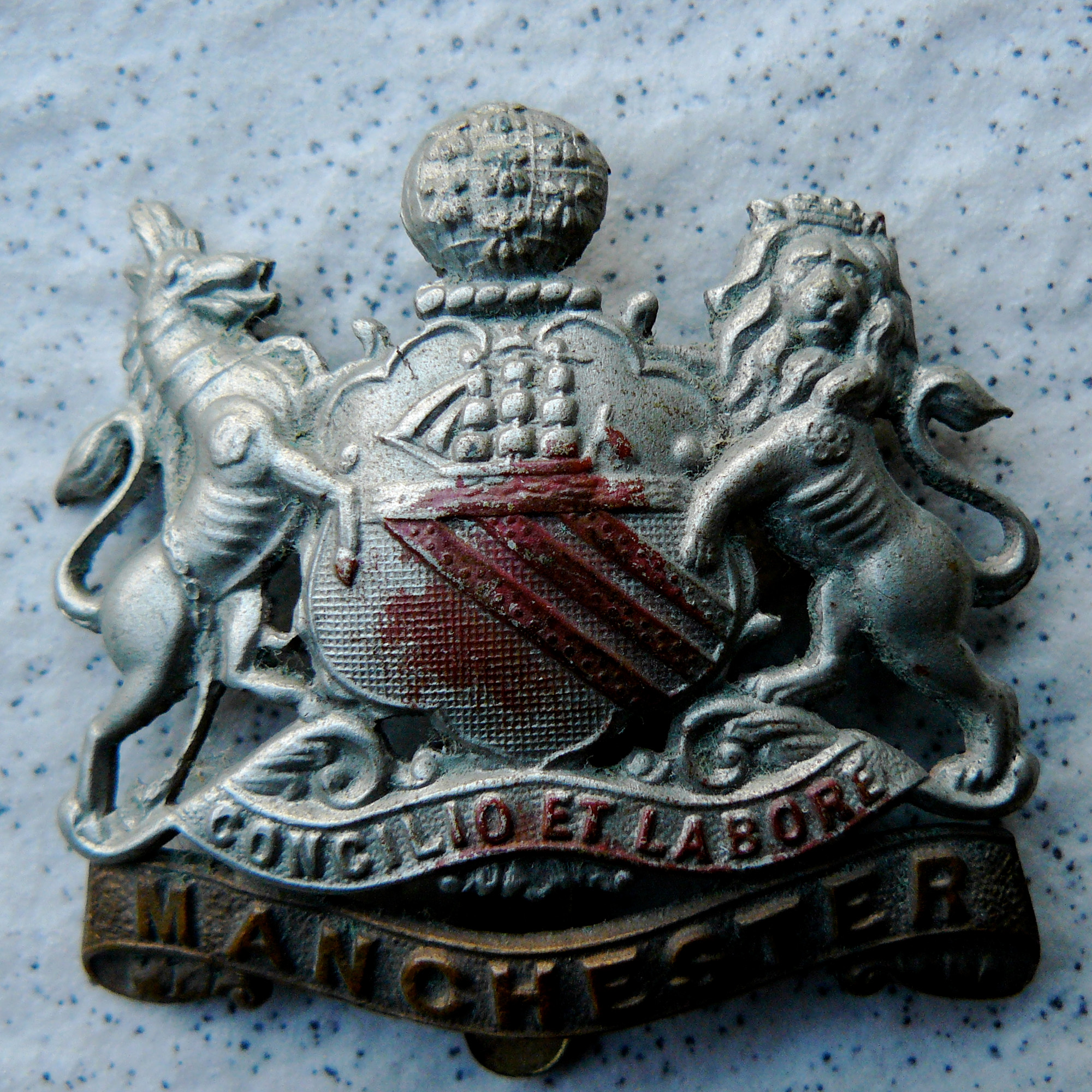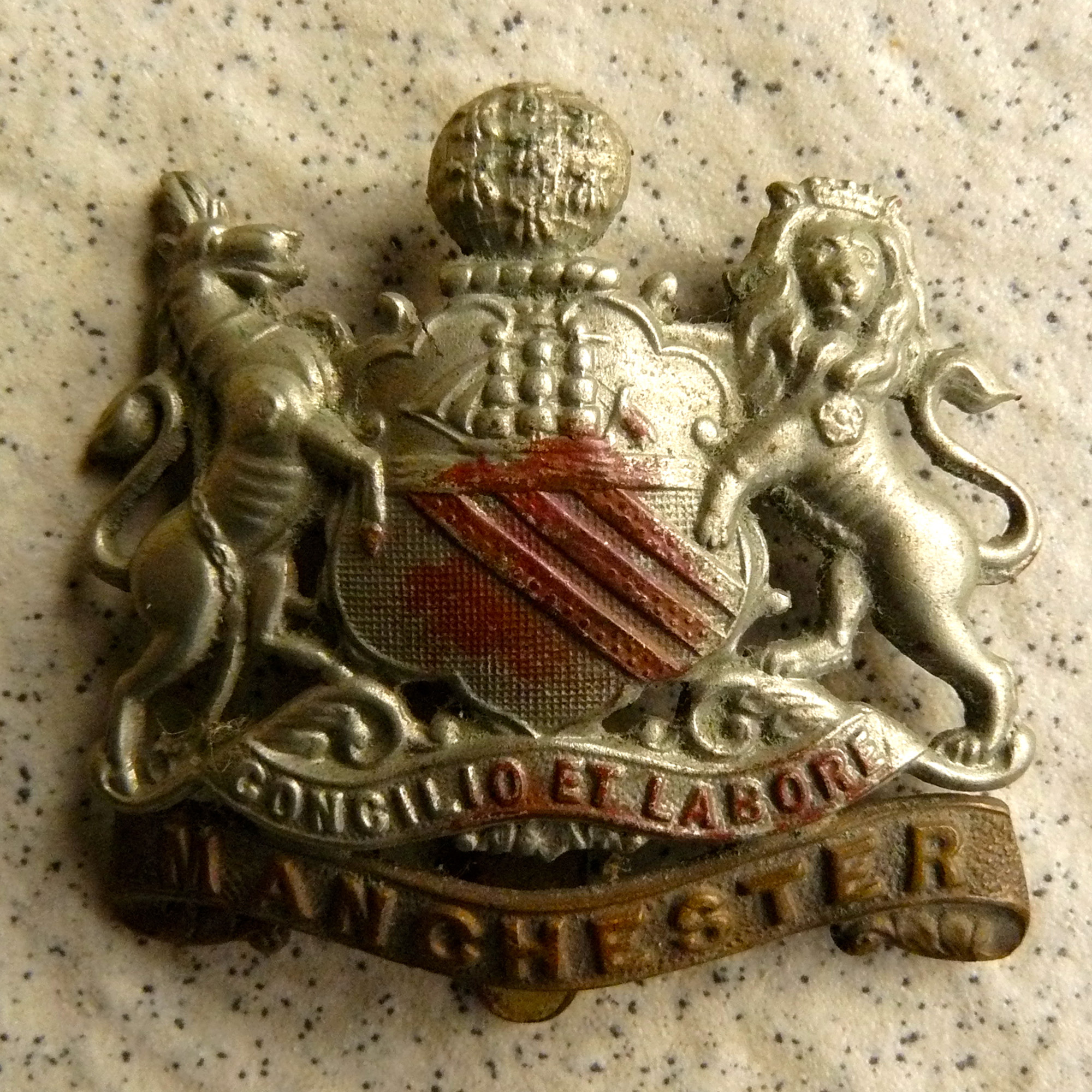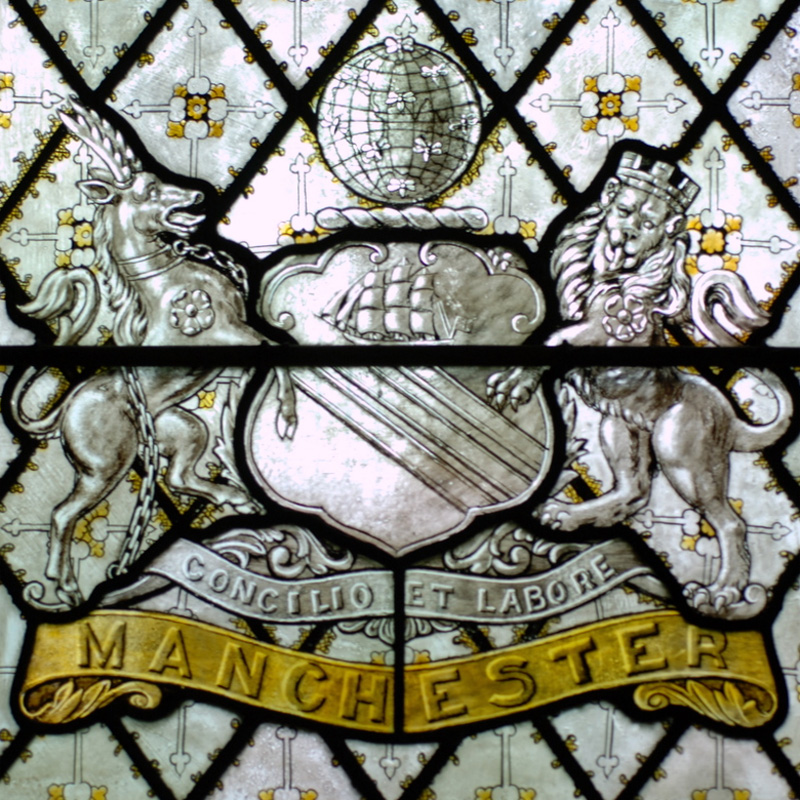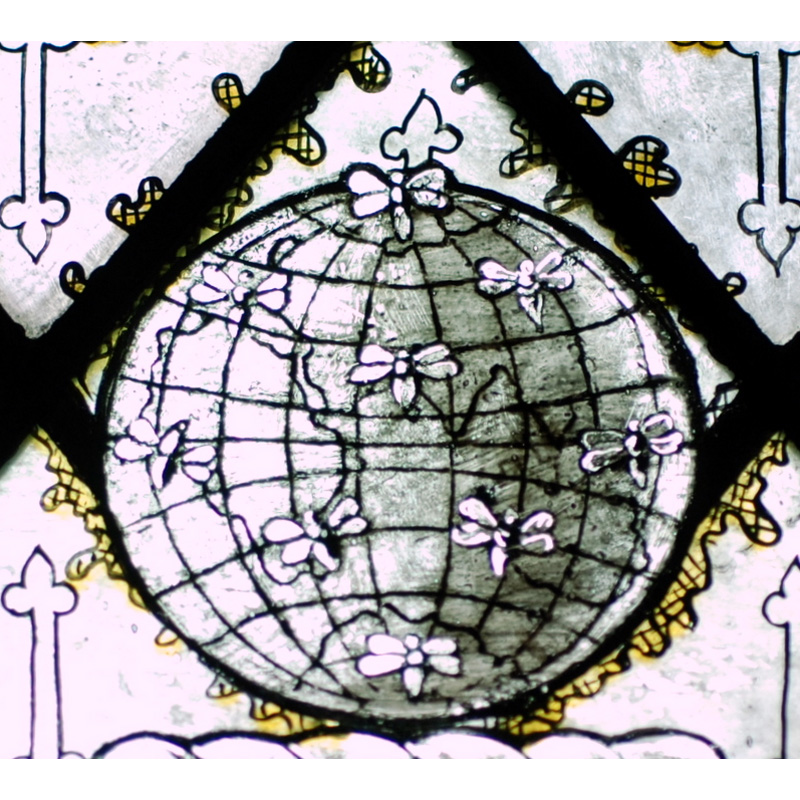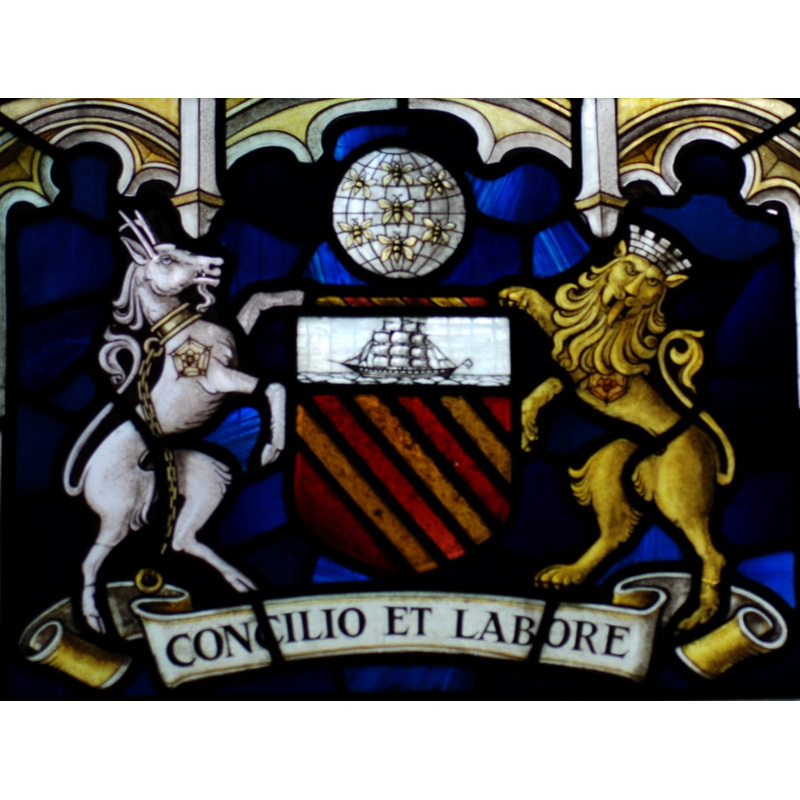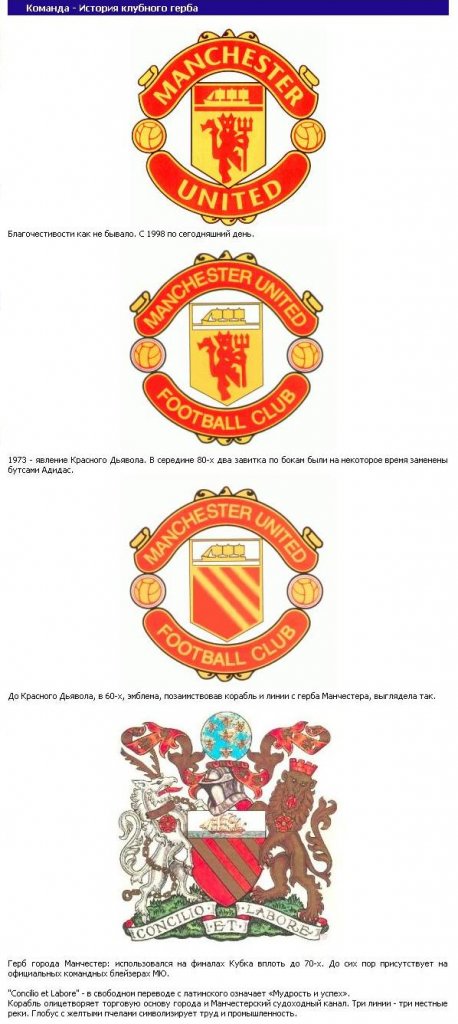Манчестер
Фигуры: - перевязь - глава - Корабль - Море - Глобус - пчела - Антилопа - лев - Девиз
The Coat of Arms of the City of Manchester
Blazon: Gules, three bendlets enhanced Or; a chief argent, thereon on waves of the sea a ship under sail proper. On a wreath of colours, a terrestrial globe semée of bees volant, all proper. On the dexter side a heraldic antelope argent, attired, and chain reflexed over the back Or, and on the sinister side a lion guardant Or, murally crowned Gules; each charged on the shoulder with a rose of the last.
Motto: Concilio Et Labore
Explanation Like all heraldic coat of arms, almost every component of the Manchester Coat of Arms has a symbolic meaning. At the centre of the shield (in a shape known as '13th-century', which Manchester chose for reasons unknown), the three diagonal stripes represent the three rivers of Manchester: The Medlock, The Irwell and The Irk.
The ship at the top of the shield represents the trading relationships of Manchester, and above the shield the terrestrial globe covered in bees also has significance. The bee in heraldic terms represents efficient industry, and to this day the bee is often used as a shorthand emblem of Manchester and can be see on many street bollards around the city centre.
The heraldic antelope with its gold chain represents the engineering industries. The lion’s crown is a castle, a reference to the ancient Roman fort of Castlefield: the first known civilised settlement of Manchester. The red roses they each wear on their shoulders are references to Lancashire, a symbol that is still used widely today to represent the county Manchester historically belongs to.
The motto can be loosely translated as 'Wisdom and Effort' although some prefer to read it as meaning something along the lines of 'Think about the consequences of your work before beginning it'.
A coat of arms was granted to the Borough of Manchester in 1842 and Manchester was granted the title of city in 1853.[5]
- The Shield: red (Gules) with three gold (Or) bands drawn diagonally across to the right hand side.
- The Chief (the white (Argent) top segment): shows a ship at sea in full sail. This is a reference to the city’s trading base.
- The Crest: On a multicoloured wreath stands a terrestrial globe, signifying Manchester’s world trade, and covered by a swarm of flying bees. The bee was adopted in the 19th century as a symbol of industrial Manchester being the birthplace of the Industrial Revolution.
- The Supporters: On the left, a heraldic antelope with a chain attached to a gold (Or) collar, representing engineering industries, and hanging at the shoulder, the red rose of Lancashire, in which county Manchester once was. On the right, a golden lion stands guardant (facing us), crowned with a red (Gules) castle (a reference to the Roman fort at Castlefield from which the city originated). The lion also wears the Red Rose of Lancashire.
- Motto: Concilio et Labore, loosely translated «By wisdom and effort» (or «By counsel and hard work»).
The arms were granted in 1842. The golden bends in red are derived from the arms of the Lords of Manchester, who ruled the city prior to 1301. The chief shows a ship in full sail, a symbol of trade and enterprise.
The crest shows a globe covered with bees, representing the world, to all parts of which the goods of the city are exported. The bees are a symbol of activity. The supporters, an antelope and a lion, are derived from the arms of King Henry IV, Duke of Lancaster.
The motto means 'By council and work', and is derived from a phrase in Ecclesiasticus 37:16 : 'Let reason be the beginning of every work and let counsel go before every action'.
Each IBD County Page has or will have (where possible) the relevant Coat of Arms. This is made possible thanks to a fantastic heraldry website called the International Civic Heraldry Website. Sometimes a description is not given due to lack of information, so if anyone could help it would be greatly appreciated. You may visit this superb site by using the link below.
The antelope, the lion and the bees
With Manchester City Council’s announcement that the city’s creative director Peter Saville is looking at new designs for their corporate identity, there’s a chance to take a closer look at their existing emblem, the official Manchester coat of arms. Design a Manchester motif
— If you had to come up with a new Manchester logo, what would it be? — Have a go and send us the results to manchester.online @bbc.co.uk — Remember, this isn’t about replacing the crest, it’s about creating something new that says Manchester to you
In short, the coat of arms is packed with information, so much so that the Council say there is absolutely no suggestion that any new design will replace it as the official badge of the city (the idea is to simply help identify the Council on things like letterheads and business cards, much like the 'In Salford' brand does on the other side of the Irwell).
Manchester’s coat of arms was granted to the city in 1842 and is a classic heraldic design, showing a shield of red and gold, bearing the image of a ship, supported by an antelope and a lion and crowned by a globe covered in bees.
And as it is heraldic, each part of it signifies or suggests an aspect of the city’s past and present 167 years ago. The Manchester coat of arms
The Manchester coat of arms
• The red shield with gold stripes is taken from the lords of Manchester, who ruled the city prior to 1301 • The ship in full sail is a reference to the city’s growing trade and enterprise • Either side of the shield are an antelope and a lion, derived from the arms of King Henry IV, which can be seen from the red Lancaster rose on their shoulders • The lion is a symbol of bravery and strength, while the antelope (referring to a mythical beast, not an actual antelope) means peace and harmony, extreme courage and discipline • At the foot is the city’s motto, Concilio Et Labore, which means 'by counsel and work', a phrase derived from the Biblical book of Ecclesiasticus • Above all this is probably the most famous part, a globe covered with bees, a symbol of industriousness
All that considered, the coat of arms proclaims Manchester as a city of global trade and industry, built on extreme courage, bravery, strength and discipline and filled with peace and harmony.
That’s quite a statement and one which means Peter Saville is probably grateful that the Council aren’t asking him for a replacement motif that goes into that level of detail.
A 1877 representation of the coat of arms granted by the Queen to the Corporation of the City of Manchester in 1842—see p. 391 of The All England law reports (1955). Darbyshire, Alfred (1887). George, Milner. ed. A Book of Olde Manchester and Salford. Manchester, United Kingdom: John Heywood. pp. 53, 136. Retrieved 2010-07-19. J. Langham, W. Palmer, W. A. Fenn, and A. Darbyshire: life of these authors yet to be determined
The coat of arms as used by the public libraries of Manchester in 1899; it is an obvious derivative of the city’s coat of arms. Credland, William Robert (1899). The Manchester Public Free Libraries: A History and Description, and Guide to Their Contents and Use. Manchester, United Kingdom: Thos. Sowler and Sons. p. Book plate II. Retrieved 2010-07-19. ca. 1877 Langton; exact identity and lifespan yet to be determined
The seal of the public libraries of Manchester in 1899; it is an obvious derivative of the city’s coat of arms. Credland, William Robert (1899). The Manchester Public Free Libraries: A History and Description, and Guide to Their Contents and Use. Manchester, United Kingdom: Thos. Sowler and Sons. p. Book plate I. Retrieved 2010-07-19. ca. 1877 Langton; exact identity and lifespan yet to be determined
Manchester City Coat of Arms on old traction standard, Heaton Park Tramway This traction standard, which helps support the overhead power lines for the tramway, has a Manchester City coat of arms on it. The standard is located outside the tram shed, which was formerly a tram shelter. P. L. Chadwick
[|http://www.phm.org.uk/whatson/mr-ordinarys-prize-book-launch/%7C The People’s History Museum]
Brass Safe Plate — John Port — Mill St — Ancoats — Manchester 22 Aug
This is a brass plate made by a company called John Port, Mill Street, Ancoats.
There is no date on the plate. The plate measures 11.4cm by 10.5cm.
The details of the plate are: By her Majesty’s Royal Letters Patent, John Port, Patent Safe Manufacturers, Mill Street, Ancoats, Manchester.
The plate also shows the City of Manchester arms dating from 1842, showing a unicorn and lion with the motto ‘CONCILIO ET LABORE’- By counsel and by labour — inscribed underneath. This is the official motto of Manchester and can be found all over the city. The ship and shield have also been used by both football teams of the city, Manchester United and Manchester City.
British Navy HMS Manchester (D95), destroyer emblem (crest)
Ceremonial key
Date unknown, sometime between 1842 and 1956 Silver gilt and enamel
Object number 1956.138 Given by the Manchester Town Hall Committee
See this object at Manchester Art Gallery This object may not always be on display. Please check with the venue before visiting. Ceremonial key
This ceremonial key, from Manchester Town Hall, shows the city’s official coat of arms. Manchester can trace its heraldic routes back to the 1200s, when Roger de Grelley was first issued with a crest. In 1301, when Manchester was granted its first charter giving the townspeople certain rights and privileges, feudal lords the de Grelley family simply applied their own shield. This shield is described as 'Gules three bendlets enhanced or', which translates as 'on a red shield three diagonal stripes in gold'. A popular myth is that the three stripes represent the three rivers, but no historical evidence supports this view.
The crest was further developed when Manchester was granted borough status in 1838. Four years later, in 1842, the city was granted a coat of arms in two stages. A ship in full sail was added above the shield to represent Manchester’s trade links to the world. Above this was placed a globe covered by a swarm of bees, which represents industry and the bee has since become the enduring symbol of the city. The motto 'Concilio et Labore', which translates as 'wisdom and effort', was also added. Shortly afterwards, supporting heraldic animals, an antelope and lion were added, although these don’t appear on this key. The roses are in reference to the county of Lancashire.
The inclusion of the ship and globe indicate how Manchester was transformed, through the cotton industry, from a small market town into a city of global importance.
This information was provided by curators from Manchester Art Gallery.
St George and the Manchester coat of arms in the central panel of the Passchendaele memorial window
THE MANCHESTER GOLD MEDAL 1889
From its earliest beginnings the Club has had strong links with the gentleman of industrial Manchester.
In 1889, 38 club members residing in or near Manchester presented a gold medal to be played for annually. On the original medal, the crest is a terrestrial globe with seven bees representing the continents and on the shield a ship in full sail from the Manchester City coat of arms.
Indeed in the formative years of the Club the excellent rail links to Manchester and the presence of numerous members from the area meant that the Club regularly placed the balloted starting times in the Thursday addition of the preceding Manchester Guardian newspaper. The Lancashire and Yorkshire railway also put on a special train, at reduced fares, from Manchester (42 miles) on Saturdays for the convenience of the golfers and a golfer’s ticket was eventually available.
It can be argued that the Clubhouse of today is in large measure down to the vision and wealth of these Manchester members. When the new links was constructed in 1896, there was a need for a Clubhouse.
At that time, in the days of the gutta percha ball and awkward hickory shafted clubs, golf had not caught on as it was to do in the decades that followed. Other clubs built modest Clubhouses commensurate with the needs of the time.
These industrialists looked for something more in keeping with their lifestyles and commissioned the architect of the recently built Royal Liverpool Clubhouse, whose grandeur in turn reflected the wealth of the Liverpool dock magnates.
So it was that in 1898 our Clubhouse was opened with due ceremony by the Marquis of Lorne.
Apart from some additions at the South end to create the current Entrance Hall, Secretary’s office and Members’ Bar, it was in 1898 largely as it is now and is viewed by many as one of the great Clubhouses in these Islands.
This medal is played for at the Autumn Meeting and is presented at the St Andrews Dinner.
Royal Lytham & St Annes Golf Club
Greater Manchester Transport Society
This coat of arms is on a plaque commemorating the reconstruction of the Gaythorn Tunnel on the Rochdale Canal in Manchester.
The Rochdale Canal was originally built between 1794 and 1804. It starts at the other under of this tunnel and runs for 32 miles across the Pennines to Sowerby Bridge. In 1902 when the plaque with the coat of arms on it was erected, the Gaythorn Tunnel was reconstructed. Actually it was opened up and a road bridgee built on top of it. The coat of arms were granted in 1842 and partly based on the arms of the Lord of Manchester wh ruled the city prior to 1301. The ship in full sail, that has been added to the shield represents trade and enterprise.
The crest has a globe with bees upon it representing the fact that Manchester traded with the rest of the world. The supporters, an antelope and a lion are derived from the arms of King Henry IV, the Duke of Lancaster. Lancaster is the county town of Lancashire.
The motto means ‘By Council and Work’ and is a partial quote from Ecclesiasticus 37:16.
Manchester Coat of arms on Queen Victoria Jubilee Fountain
This hexagonal fountain in Albert Square was erected to celebrate Queen Victoria’s Diamond Jubilee, later moved to Heaton Park, and 100 years after it was erected was moved back to Albert Square.
On one side of the fountain is the coat of arms of Manchester, showing that city was proud to dedicate the fountain to Queen Victoria.
The coat of arms were granted in 1842, before Manchester became a city and partly based on the arms of the Lord of Manchester who ruled Manchester prior to 1301. The ship in full sail that has been added to the shield represents trade and enterprise.
The crest has a globe with bees upon it representing the fact that Manchester is an industrial city that trades with the rest of the world.
At the time the arms were granted Manchester was in the county of Lancashire and Lancaster was the county town of Lancashire. The Latin motto ‘Concilio et Labore’ means ‘By Council and Work’ and is a partial quote from Ecclesiasticus 37:16.
«Concilio et Labore» is the city of Manchester’s motto, which losely translated means «Wisdom and Effort», although some prefer to read it as meaning something along the lines of ‘Think about the consequences of your work before beginning it’. The ship represents the trading relationships of Manchester, and the globe covered in bees also has significance.
The bee in heraldic terms represents efficient industry, and to this day the bee is often used as a shorthand emblem of Manchester. The white heraldic antelope with its chain represents the engineering industries. The lion’s crown is a castle, a reference to the ancient Roman fort of Castlefield and the red roses they each wear on their shoulders are references to Lancashire.
City of Manchester coat of arms on Peter Stevenson’s former Manchester City Transport
Coat of arms of Manchester under Town Hall tower
Coat of arms of Manchester under Town Hall tower The coat of arms is on a trap door which can be moved to allow bells to be lowered to the ground. The coat of arms is rather different from most illustrations I have seen, e.g. that on mission072.blogspot LinkExternal link which sets out the blazon and explains the meaning. The blazon has above the shield a wreath of colours. The example here has above the shield a plant with red flowers — I think they must be a heraldic representation of either the red rose of Lancaster, or possibly of cotton. The globe in the middle of the plant has on it bees, representing efficient industry.
The coat of arms of Manchester City Council, Lune Waterworks Bridge The motto reads «Concilio et Labore».
Manchester Old and New Vol.I, Cassell & Co, c.1894.
Also, this was a new coat of arms for Manchester that was brought in during the mid 1950s:
Notice how it is the same as the current City crest? And the same as this, worn on our shirt in the 1958 cup final?:
Many people believe the crest on the 1958 shirt to represent a phoenix, as though signaling the club’s resurrection after the Munich Air Disaster that year, but actually it was just the contemporary City arms, and the bird is an eagle.
Also, in case you were wondering, the three stars above City’s badge are — according to their own website — «Purely decorative»!
См. эмблему футбольного клуба «Манчестер сити»
Manchester coat of arms above main entrance to Central Library
Like all heraldic coat of arms, almost every component of the Manchester Coat of Arms has a symbolic meaning. At the centre of the shield (in a shape known as '13th-century', which Manchester chose for reasons unknown), the three diagonal stripes represent the three rivers of Manchester: The Medlock, The Irwell and The Irk.
The ship at the top of the shield represents the trading relationships of Manchester, and above the shield the terrestrial globe covered in bees also has significance. The bee in heraldic terms represents efficient industry, and to this day the bee is often used as a shorthand emblem of Manchester and can be seen on many street bollards around the city centre.
The heraldic antelope with its gold chain represents the engineering industries. The lion’s crown is a castle, a reference to the ancient Roman fort of Castlefield: the first known civilised settlement of Manchester. The red roses they each wear on their shoulders are references to Lancashire, a symbol that is still used widely today to represent the county Manchester historically belongs to. (d’après Adrian)
«Sagesse et effort» de Manchester, insigne donné à mon beau-père par un soldat venu de Manchester
Like all heraldic coat of arms, almost every component of the Manchester Coat of Arms has a symbolic meaning. At the centre of the shield (in a shape known as '13th-century', which Manchester chose for reasons unknown), the three diagonal stripes represent the three rivers of Manchester: The Medlock, The Irwell and The Irk.
The ship at the top of the shield represents the trading relationships of Manchester, and above the shield the terrestrial globe covered in bees also has significance. The bee in heraldic terms represents efficient industry, and to this day the bee is often used as a shorthand emblem of Manchester and can be seen on many street bollards around the city centre.
The heraldic antelope with its gold chain represents the engineering industries. The lion’s crown is a castle, a reference to the ancient Roman fort of Castlefield: the first known civilised settlement of Manchester. The red roses they each wear on their shoulders are references to Lancashire, a symbol that is still used widely today to represent the county Manchester historically belongs to. (d’après Adrian)
Manchester Coat of Arms
This is by Burlison & Grylls
flickr by Fiona Moate| flickr by Fiona Moate|
Manchester Coat of Arms
This is from the Victoria Park War Memorial & is by Walter Pearce
